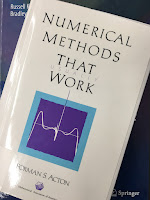The article describes how citizens of Virginia Beach opposed an offshore renewable energy project, justifying their opposition in part because of possible health hazards from electric and magnetic fields produced by transmission cables.
The article started off well and discussed many of the issues described in Chapter 9 of Intermediate Physics for Medicine and Biology and in my book Are Electromagnetic Fields Making Me Ill? (which, by the way, does follow Garfinkle’s rule of the title question having “no” for an answer). Then, suddenly, Lewis and Dong took a bizarre turn. They wrote
In repeated experiments, Nobel Prize laureate Professor Luc Montagnier amazingly demonstrated that a low intensity electromagnetic field (EMF) of 7 HZ (similar to Schumann resonances), could produce DNA in a tube of pure water, simply by being adjacent to another tube containing DNA. In other words, he created something—DNA—out of nothing, simply by being close to DNA and adding low frequency EMFs.Wait... What?! This sounded serious enough that I decided to look into it. After all, the idea was championed by one of the discovers of HIV, the virus responsible for AIDS.
 |
| Luc Montagnier in 2008 Prolineserver, GFDL 1.2, via Wikimedia Commons |
A novel property of DNA is described: the capacity of some bacterial DNA sequences to induce electromagnetic waves at high aqueous dilutions. It appears to be a resonance phenomenon triggered by the ambient electromagnetic background of very low frequency waves. The genomic DNA of most pathogenic bacteria contains sequences which are able to generate such signals. This opens the way to the development of highly sensitive detection system for chronic bacterial infections in human and animal diseases.The key phrase in the abstract is “at high aqueous dilutions.” The authors repeatedly made 10:1 dilutions of the DNA solution. After 18 dilutions, the concentration of DNA should be 0.000000000000000001 times what it was originally. The purported electromagnetic wave effect persisted, even though there was no DNA left in the sample. The water “remembered” the DNA. It’s homeopathy all over again.
Oh, Myyy! This is the worst sort of pseudoscience.
A 2010 interview in Science politely hinted that this idea is absurd.
Virologist and Nobel laureate Luc Montagnier announced earlier this month that, at age 78, he will take on the leadership of a new research institute at Jiaotong University in Shanghai. What has shocked many scientists, however, isn’t Montagnier’s departure from France but what he plans to study in China: electromagnetic waves that Montagnier says emanate from the highly diluted DNA of various pathogens…
But Montagnier’s new direction evokes one of the most notorious affairs in French science: the “water memory” study by immunologist Jacques Benveniste. Benveniste, who died in 2004, claimed in a 1988 Nature paper that IgE antibodies have an effect on a certain cell type even after being diluted by a factor of 10120. His claim was interpreted by many as evidence for homeopathy, which uses extreme dilutions that most scientists say can’t possibly have a biological effect. After a weeklong investigation at Benveniste’s lab, Nature called the paper a “delusion.”
Here’s part of the interview with Montagnier.
Q: You have called Benveniste a modern Galileo. Why?
L.M.: Benveniste was rejected by everybody, because he was too far ahead. He lost everything, his lab, his money. … I think he was mostly right, but the problem was that his results weren’t 100% reproducible.
Q: Do you think there’s something to homeopathy as well?
L.M.: I can’t say that homeopathy is right in everything. What I can say now is that the high dilutions are right. High dilutions of something are not nothing. They are water structures which mimic the original molecules. We find that with DNA, we cannot work at the extremely high dilutions used in homeopathy; we cannot go further than a 10−18 dilution, or we lose the signal. But even at 10−18, you can calculate that there is not a single molecule of DNA left. And yet we detect a signal.
Why should we care about all this silliness? Wouldn’t it be better to just ignore it? Here’s the problem: Climate change is real. There’s a consensus among scientists that it’s a serious, man-made crisis that must be addressed. One way to fight climate change it is to build alternative sources of energy, such as offshore wind farms. Yet citizens and journalists are citing ridiculous nonsense like Montagnier’s water memory hypothesis to oppose wind farms. Quackery and voodoo science are being used to impede solutions to what may be the most dire challenge mankind has ever faced.
To quote Charles Dickens, “I’ll retire to bedlam.”
Co-discoverer of HIV Luc Montagnier dies aged 89. BBC News
https://www.youtube.com/watch?v=Iat2FncJ1to
What is Homeopathy, by Science Saves.
https://www.youtube.com/watch?v=Rw766-Z97BI














